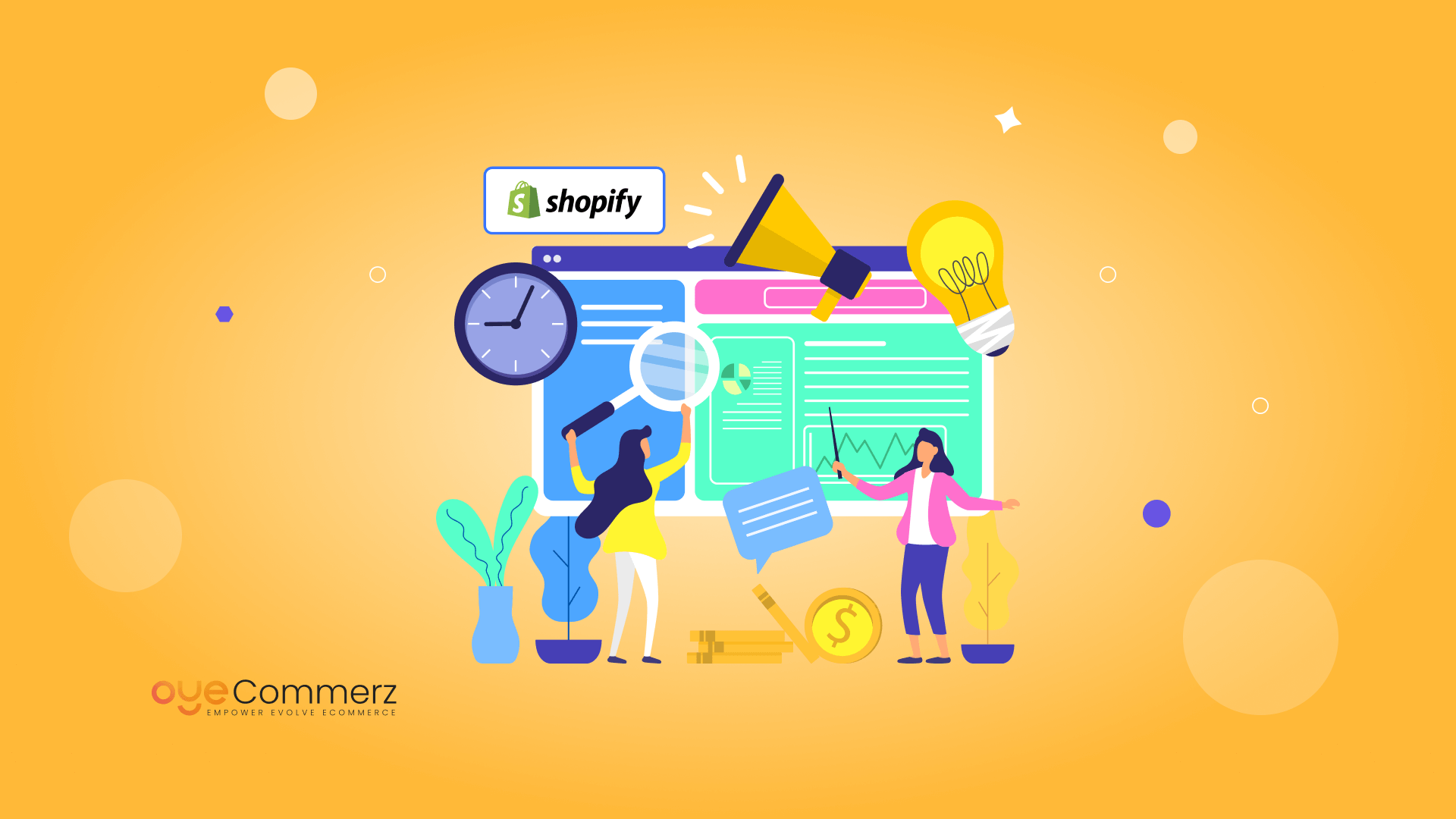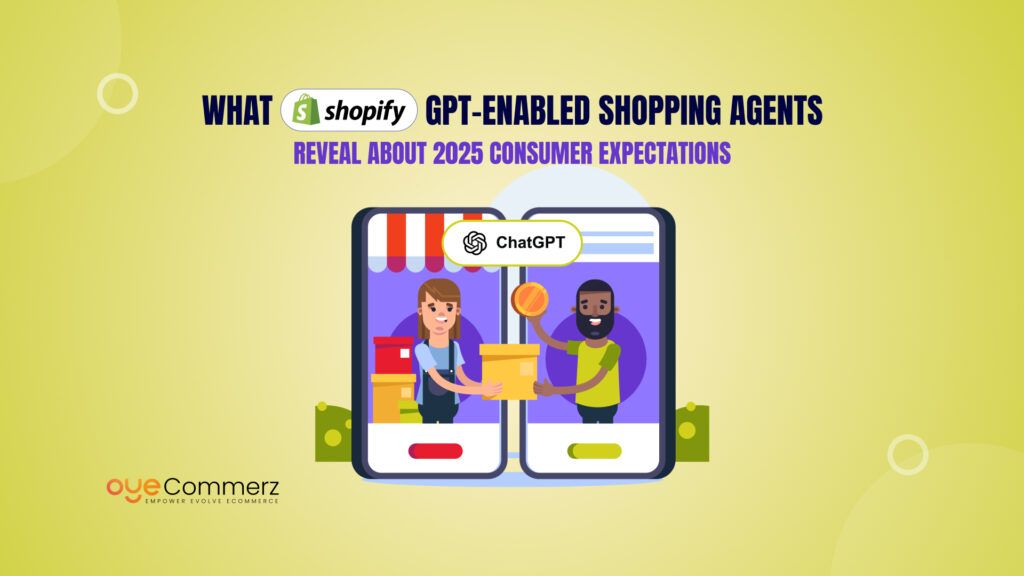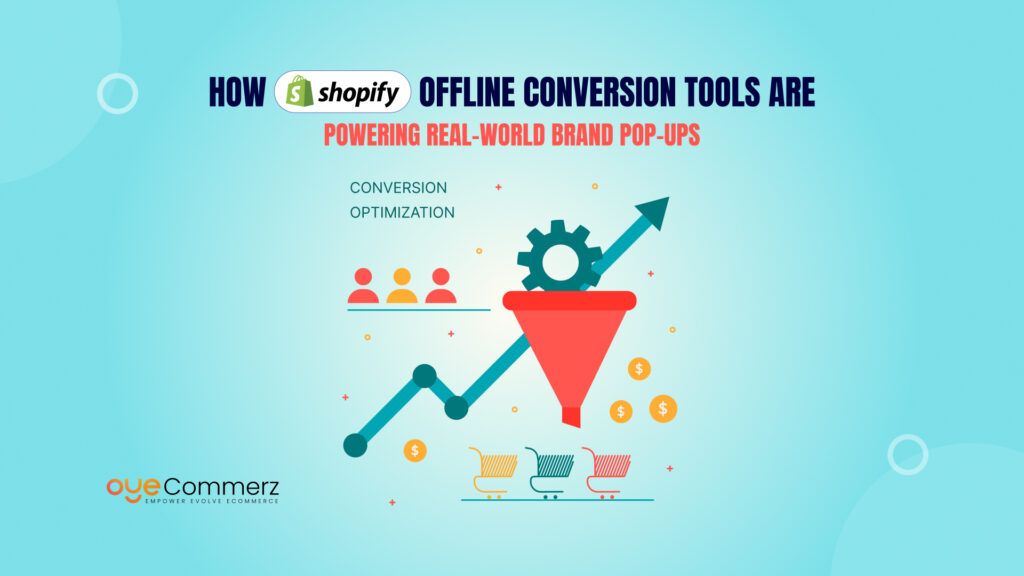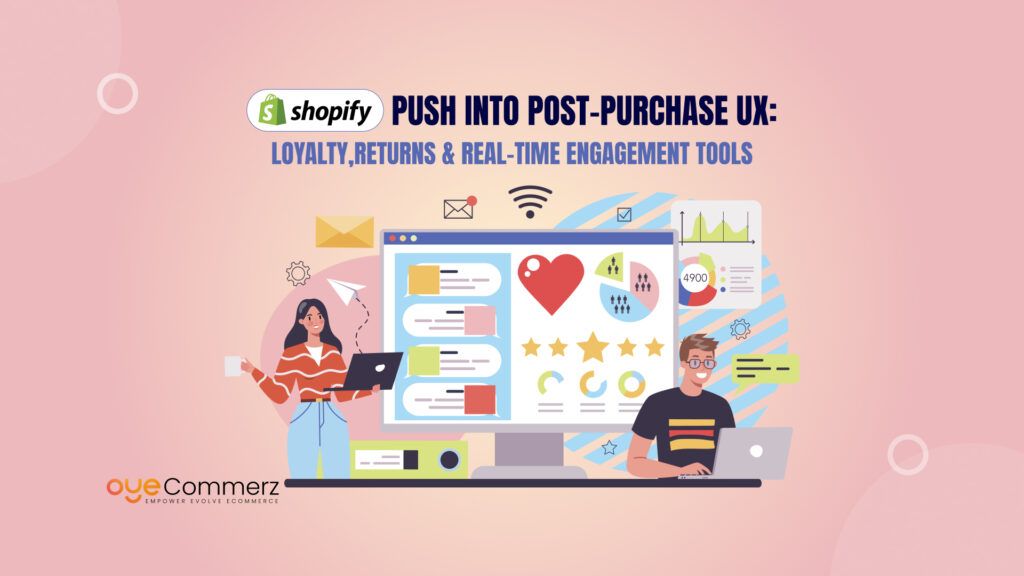Shopify offers an Easy and effective solution for creating and running online stores with which you’re already familiar. It’s also why the platform is so widely used, with over 4.6 million Shopify stores as of June 2024. Simply launching a Shopify store doesn’t guarantee a flow of customers.
To be successful, you must apply Different marketing tools and strategies to make different from others. In this article, we will outline Best Digital marketing strategies for promoting Shopify Apps specifically and drive business growth.
Table of Contents
ToggleWhat is Shopify Marketing?
Shopify marketing Offers a range of digital strategies, tactics, and tools designed to promote your Shopify store or app, attract customers, and ultimately drive sales. Whether you’re a Shopify app developer or a store owner, effective marketing is essential for reaching potential customers, converting leads into buyers, and maintaining long-term customer relationships. Shopify provides built-in features and integrations that make it easier to market your products or apps, but a strategic approach is still necessary to stand out in an increasingly competitive market.
Why is Shopify Marketing Important?
Shopify’s popularity as an e-commerce platform is clear, with millions of stores operating globally. While Shopify makes it simple to set up a store, the challenge lies in attracting and retaining customers. The higher volume of businesses on Shopify creates a competitive environment where effective marketing becomes the key to success. Without a proper marketing plan, it’s difficult for stores or apps to be discovered, even if they offer high-quality products or services. This is where Shopify marketing comes into play, helping businesses build brand visibility, generate traffic, and optimize conversions.
Shopify marketing focuses on using various channels such as search engines, social media, email marketing, paid ads, and content marketing to reach potential customers. It also involves utilizing Shopify’s ecosystem of marketing tools and third-party integrations to maximize the effectiveness of these efforts.
Understanding the Importance of Digital Marketing for Shopify Apps
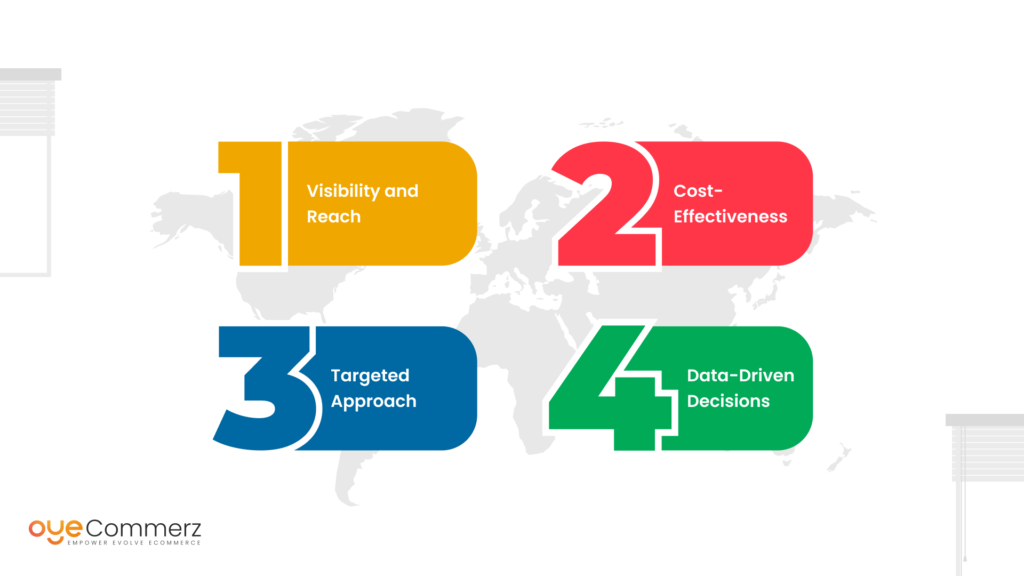
Digital marketing is more than a trend but a necessity in the current state of the market especially for e-commerce companies. To Shopify app developers, digital marketing is the connection between your app and the potential users out there. More than anything else, all these highlight the need for a sound digital marketing strategy where app development does not have to be innovative but intelligent.
Why Digital Marketing Matters for Shopify Apps:
Visibility and Reach
There are millions of e-commerce businesses across the globe and this makes it difficult to be unique or unique just because of the app that is being developed. SEO and Social media marketing alone have a very important role to play in making your app popular and reachable to its target audiences.
Cost-Effectiveness
‘Organic’ reaching, in contrast to non-organic conventional promoting associated with high costs and generally less specific reach. Through digital marketing, you get to the specific audience more cheaply hence maximizing the ROI.
Targeted Approach
A targeted approach in digital marketing ensures that your campaigns reach the right audience, maximizing efficiency and ROI. To take it a step further, scaling your business with a custom Shopify app allows for more personalized marketing strategies, enhancing user engagement and driving sustained growth.
Data-Driven Decisions
Digital marketing offers a lot of information that assists in decision-making. You will be able to reconsider your strategies and whether they are more effective by evaluating engagement, click-through rates, and conversion rates.
Building an Effective Brand for Shopify App
The brand is the dominant concept in that a unique and consistent image is critical to the success of specific web-based marketing communications. It is the thing that makes your Shopify app unique and establishes an overnight brand recall among the user base. However, positioning a brand beyond the realm of a good graphic design, a memorable slogan, or a catchy phrase goes hand-in-hand with the need to achieve consistency and effectiveness of the narrative being conveyed.
Key Elements of a Strong Brand Identity
Brand Vision and Mission
Since your page is a representation of your app, be very specific in what it symbolizes or represents about your Shopify app. What is the issue that fits into this and is solved by it? Which norms does it reflect? The brand vision and mission must be implemented into the marketing aspect fully in the domain such as website and social pages.
Unique Selling Proposition (USP)
What is unique about the content of your app? Customers should also be able to identify the unique selling proposition of the business in marketing documents. Ideally, it must be the ultimate promise to customers: if it’s resolved in the copy, your unique selling proposition should be a focal part of the brand.
Visual Identity
Unity of the graphic, both of the logo, and of colors, typography, and graphic items, must be organically combined. This not only makes your brand easily identifiable but also assists in building credibility and genuineness.
Brand Voice and Tone
How you convey your message is just as important as your message itself since it determines the impression you create on your audience. When defining your brand voice, you need to remember that it should be the same regardless of the platform you are using: serious, playful, or authoritative.
User-Centric Approach
In line with creating a brand identity that resonates with your users, boosting customer engagement with a custom Shopify app can significantly enhance the user experience. A tailored app ensures that your customers feel valued and understood, which is crucial for long-term brand loyalty. This, in turn, gives your audience a chance to identify with you and create a bond with you.
Best Shopify Marketing Strategies For Promoting Shopify App
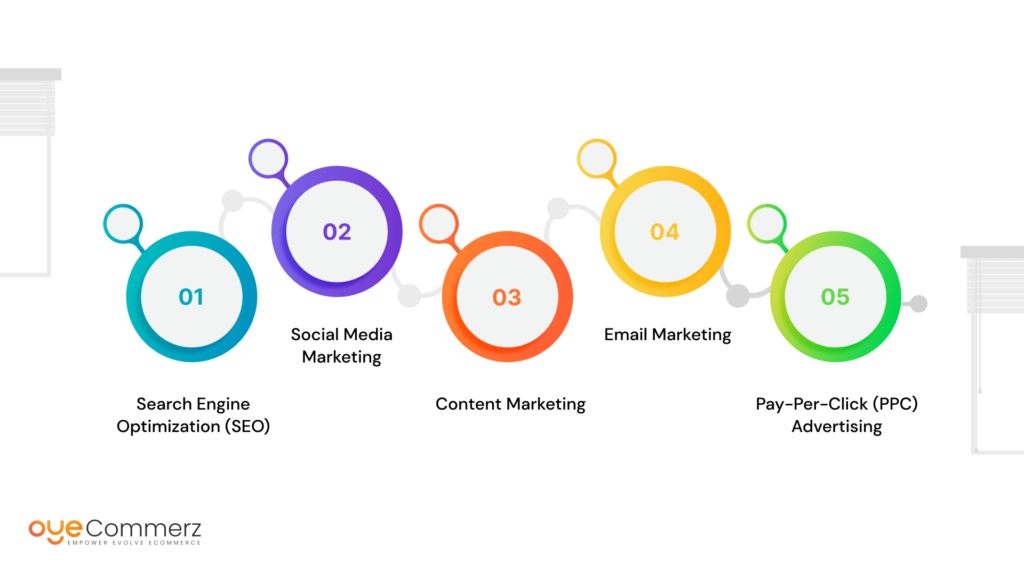
Here are some of the best marketing ideas to help you promote your Shopify app and get ahead in the competitive app marketplace.
1. Content Marketing
Content marketing is a strategic approach centred on creating and distributing valuable and relevant content to attract and engage a specific target audience. Promoting your Shopify app plays a pivotal role in establishing brand authority, driving traffic, and ultimately converting visitors into users.
To effectively utilize content marketing, start by identifying your target audience Shopify merchants and understanding their pain points, challenges, and needs. This understanding will guide you in creating tailored content that addresses their specific concerns and provides solutions through your app.
Blogging and Educational Resources
A well-maintained blog can serve as a cornerstone of your content marketing strategy. Publish articles that offer insights into e-commerce trends, best practices, and detailed tutorials on using your app. By providing valuable information, you not only position your brand as an industry expert but also attract organic traffic from search engines.
Case Studies and Testimonials
Sharing case studies that illustrate how your app has helped specific merchants achieve their goals can significantly influence potential users. Highlight measurable outcomes, such as increased sales or improved operational efficiency, to showcase your app’s effectiveness. Including testimonials from satisfied users adds social proof, making your app more appealing to prospects.
SEO Optimization
Implement search engine optimization (SEO) techniques in your content to increase its visibility. Research relevant keywords that potential users might search for and integrate them naturally into your blog posts, product descriptions, and metadata. This optimization will help your content rank higher in search engine results, driving more traffic to your app’s listing.
2. Search Engine Optimization (SEO)
Search Engine Optimization (SEO) is a crucial digital marketing strategy focused on optimizing your online content to enhance visibility in search engine results. For promoting your Shopify app, effective SEO practices can significantly enhance your app’s discoverability, attracting potential users and driving organic traffic. Here’s how to leverage SEO effectively for your Shopify app:
1. Keyword Research
The cornerstone of SEO lies in keyword research, which involves identifying the words and phrases your target audience is likely to search for when seeking apps like yours or related products. Utilize tools like Google Keyword Planner, SEMrush, or Ahrefs to discover relevant keywords that align with your app’s features and functionalities. The goal is to target both short and long-tail keywords, as the latter frequently reflects higher purchase terms. For example, instead of just targeting “Shopify app,” consider long-tail keywords like “best Shopify app for inventory management.”
2. Optimized Product Page
Your application’s product page plays a vital role in your SEO strategy. Ensure that the page is optimized with relevant keywords, particularly in the title, headings, and product descriptions. Create a compelling and concise description that clearly outlines the benefits of your app, addressing the specific pain points of potential users. Incorporate appealing visuals, including high-quality images and instructional videos, to enhance the user experience and maintain user engagement.
3. Technical SEO
Technical SEO involves optimizing your website’s structure to facilitate easier crawling and indexing by search engines in search engine results pages (SERPs). It’s essential to ensure that your app’s website is mobile-friendly, given the growing number of users who access content through mobile devices. Additionally, improving site speed is critical, as slow-loading pages can adversely impact user experience and negatively affect rankings. Implementing structured data markup is another key method, as it helps search engines better understand your content and optimize the display of rich snippets in search results. By focusing on these technical elements, you can significantly improve your app’s visibility and performance in search engine rankings.
4. Quality Content Creation
Creating high-quality, informative content is crucial for boosting your SEO. Regularly publishing blog posts, guides, and tutorials that resonate with your audience helps drive traffic while also encouraging other websites to link back to your content, enhancing your authority in search engine rankings. Focus on answering common questions and offering actionable insights that help businesses optimize their Shopify stores. This content strategy positions your brand as a valuable resource increases engagement, and improves the likelihood of acquiring backlinks from reputable sources.
5. Link Building
Building backlinks from reputable websites enhances your app’s authority and improves its search engine rankings. Strategies like guest blogging, collaborating with industry influencers, and engaging in relevant online forums or communities can help generate these valuable backlinks. Each backlink serves as a vote of confidence for your app, signalling to search engines that your content is reliable and worth promoting. By increasing the number of quality backlinks, you strengthen your app’s visibility and credibility, driving more organic traffic to your Shopify store.
3. App Store Optimization (ASO)
App Store Optimization (ASO) is an important process that improves your application’s visibility and conversion rates within the Shopify App Store. ASO involves optimizing various elements of your app listing to ensure it attracts potential users and encourages downloads. Here are the components to work on for enhanced ASO:
1. Compelling Title and Description
The title is one of the most important parts of ASO. Use relevant keywords in your app name to improve searchability while keeping it concise and memorable. The app description should clearly articulate the unique value proposition (UVP) of your app, detailing its features and benefits. Ensure that the first few lines are particularly engaging, as they often appear in search results and need to capture users’ attention quickly.
2. Visual Assets
High-quality visual elements are essential for attracting users. Use eye-catching images and an engaging demo video that shows your app’s interface and operations. These visuals should highlight the app’s key features and how they solve common merchant pain points. A well-designed app icon is also vital; it should be visually appealing and representative of your brand identity.
3. Encouraging Reviews and Ratings
Positive user reviews and high ratings significantly influence potential users’ decisions. Encourage customers to leave reviews and feedback on your app’s listing page. Responding to reviews, both positive and negative, demonstrates engagement and can foster trust among prospective users.
4. Regular Updates
Frequent updates not only improve app performance and introduce new features but also signal to users that you are committed to providing value. Each update presents an opportunity to refresh your app listing with new keywords, screenshots, and promotional content, keeping it relevant in the ever-evolving marketplace.
4. Social Media Marketing
Social media marketing is a strong approach for promoting your Shopify app and engaging with your target audience. With billions of active users across various platforms, leveraging social media can enhance your app’s visibility, build brand awareness, and drive user acquisition. Here are key components to consider:
1. Platform Selection
Locate the social media channels where your target audience is most active. For e-commerce, platforms like Facebook, Instagram, LinkedIn, and Twitter are particularly effective. Each platform has different demographics and engagement styles, so alter your content to fit the specific audience of each channel.
2. Content Creation
Create engaging and informative content that connects with your users. This can include:
- Educational Posts: Share tips, best practices, and industry perceptions that help merchants optimize their stores and utilize apps efficiently.
- Visual Content: Use high-quality images, informational graphics, and videos to show your app’s features and benefits. Video tutorials and walkthroughs can be especially effective in showcasing your app in action.
- User-Generated Content: Motivate your users to share their experiences with your app by creating and posting content such as reviews, testimonials, or social media posts.UGC highlights authentic customer satisfaction, boosting trust and credibility for your app, and encourages others to engage with it.
3. Paid Advertising
Investing in paid advertising on social media can increase your reach notably. Platforms like Facebook and Instagram offer robust ad targeting options, allowing you to reach specific demographics, interests, and behaviours. Create compelling ad copy and visuals that highlight your app’s unique features and encourage downloads.
4. Engagement and Community Building
Engage actively with your audience by responding to comments, addressing questions, and joining relevant discussions. This helps build a strong community around your app, fostering customer loyalty and driving word-of-mouth referrals. Additionally, hosting live Q&A sessions or webinars provides an opportunity for real-time interaction with potential users, allowing you to address their concerns and showcase your app’s features directly. These efforts create a sense of connection and trust, making your audience more likely to become advocates for your app.
5. Email Marketing
Email marketing is a necessary tool for promoting your Shopify app and nurturing relationships with potential and existing users. Email marketing facilitates direct communication, enabling you to send personalized content, updates, and promotions straight to your audience’s inbox. Here are some methods for successful email marketing:
1. Build a Targeted Email List
Begin by creating a segmented email list that categorizes potential users, current customers, and leads. Collect email addresses using sign-up forms on your website, inside your app, and across social media platforms. To drive sign-ups, offer incentives such as exclusive content, discounts, or early access to new features. This targeted approach helps you build a more personalised and effective email marketing strategy tailored to each group’s specific needs and interests within your audience.
2. Personalized Content
Personalization plays a key role in email marketing success. Customize your emails by taking into account user behaviour, preferences, and demographic information. Segment your audience to deliver targeted messages that appeal to specific groups. For instance, onboarding emails for new users could feature tutorials and best practices. In contrast, long-time users might receive notifications about feature updates and tips on getting the most out of the app. This tailored approach boosts engagement and relevance, enhancing the effectiveness of your campaigns.
3. Lifecycle Email Campaigns
Use lifecycle email campaigns that respond to different stages of the user journey. For instance:
- Onboarding Series: Guide new users through the app setup process, offering tips and resources to help them get started.
- Engagement Emails: Send regular newsletters featuring product updates, success stories, and industry insights to keep users engaged.
- Re-engagement Campaigns: Pinpoint users who have become inactive and develop tailored campaigns aimed at reactivating them. Emphasize new features, updates, or exclusive promotions to entice them back to your app or service.
4. A/B Testing and Analytics
Regularly improve your email campaigns by running A/B tests on elements like subject lines, content, and calls to action (CTAs). Evaluate essential metrics like open rates, click-through rates, and conversion rates to determine what appeals most to your audience. Leverage this data to fine-tune your strategies and enhance the effectiveness of future campaigns.
6. Pay-Per-Click Advertising (PPC)
Pay-per-click (PPC) advertising is an effective digital marketing approach that allows you to capture targeted traffic to your Shopify application through paid search engine advertisements and social media promotions. This model enables you to reach potential users at the precise moment they are searching for solutions your app provides, maximizing your chances of conversion. Here’s how to leverage PPC effectively:
1. Keyword Research and Selection
Start with comprehensive keyword research to identify the terms and phrases that potential users are searching for about your app. Tools like Google Ads Keyword Planner and SEMrush can help you uncover relevant keywords with high search volume and manageable competition. Focus on both broad and long-tail keywords that directly relate to your app’s features and benefits.
2. Ad Creation
Craft compelling ad copy that communicates your app’s unique value proposition (UVP). Highlight key features, benefits, and any special offers, such as free trials or discounts. Use good calls to action (CTAs) to advances users to click on your ad. Incorporate visually appealing images or videos, especially in social media campaigns, to enhance engagement.
3. Targeting Options
Take the lead in the advanced targeting choices available on platforms like Google Ads and social media sites. Prepare your target audience based on demographics, interests, behaviours, and location to make sure your ads target the right people. You can also use remarketing to again target users who have previously interacted with your app.
4. Budget Management and Optimization
Set a budget that matches your marketing goals and track your spending closely. Constantly analyze the performance of your PPC campaigns, focusing on metrics such as click-through rates (CTR), conversion rates, and return on investment (ROI). Add A/B testing to try with different ad types and use it for better performance.
7. Continuous Performance Analysis
Continuous performance analysis is an essential practice for optimizing your Shopify app’s effectiveness and ensuring sustained growth. This approach involves regularly monitoring, evaluating, and adjusting various performance metrics to enhance user experience, improve functionality, and drive user engagement. Here’s how to do continuous performance analysis:
1. Define Key Performance Indicators (KPIs)
Identifying the KPIs that are most effective for your app’s objectives. Common KPIs for Shopify apps include user acquisition rates, churn rates, active user counts, session duration, and conversion rates. Defining clear KPIs helps you measure success and understand areas needing improvement.
2. Implement Analytics Tools
Utilize analytics tools such as Google Analytics, Mixpanel, or Shopify’s built-in analytics to gather data on user behaviour and app performance. These tools can provide insights into user engagement, feature utilization, and traffic sources, allowing you to make data-driven decisions.
3. Regular Review and Reporting
Establish a routine for reviewing performance metrics, such as weekly or monthly reports. Analyze trends over time to identify patterns, potential issues, and opportunities for enhancement. Reporting should highlight not only successes but also areas where the app may be underperforming, enabling proactive adjustments.
4. User Feedback and A/B Testing
Work on user feedback to get insights into their experiences with your app. Conduct surveys or solicit reviews to understand pain points and areas for improvement. Additionally, use A/B testing to experiment with changes to features, layouts, or marketing messages, allowing you to compare results and refine your strategies.
5. Iterate and Optimize
Based on the data collected and feedback received, iterate on your app’s design and functionality. Continuous improvement is vital to keeping your app competitive and meeting user needs. Regularly updating and optimizing your app ensures it remains relevant and valuable to users.
8. Automated Marketing
Automated marketing is a critical component for scaling your Shopify store or app efficiently. It involves using software tools and integrations to automate repetitive marketing tasks like email campaigns, social media posts, customer segmentation, and personalized outreach. From a technical standpoint, setting up automated marketing requires a clear understanding of the tools and workflows that integrate seamlessly with your Shopify store or app.
Leveraging Shopify Integrations for Automation
Shopify’s ecosystem offers a variety of built-in marketing automation features, along with third-party apps that further enhance automation capabilities. Shopify Flow, for example, is a powerful tool that automates tasks like tagging high-value customers, re-engaging abandoned carts, or sending follow-up emails based on specific triggers. Additionally, using apps like Klaviyo or Mailchimp, you can automate complex email marketing campaigns that are triggered by user actions such as purchases, sign-ups, or even product views.
Setting up automated workflows involves connecting Shopify with these marketing platforms via APIs and ensuring seamless data synchronization. You can create dynamic segments of your audience based on real-time behavioural data, which allows for highly targeted campaigns.
Personalization at Scale
One of the technical benefits of automated marketing is the ability to personalize at scale. By using machine learning and AI-powered tools, you can tailor content for individual customers based on their browsing behaviour, purchase history, and engagement levels. Shopify’s API allows developers to pull detailed customer data and set up triggers for personalized product recommendations, discount offers, or loyalty rewards.
9. Create Marketing Campaigns for Retention and Upsells
Once a merchant begins using your app, it’s essential to maintain engagement to encourage retention and identify upsell opportunities. Effective marketing strategies can foster a sense of loyalty, enhance user satisfaction, and ultimately drive additional revenue. Here are some targeted approaches to consider:
1. Lifecycle Email Campaigns
Lifecycle email campaigns are an effective way to keep users informed and engaged with your app. By segmenting your email list based on user behaviour and app usage, you can send personalized newsletters that resonate with specific audience segments. Consider the following tactics:
- Feature Highlights: Regularly update your users about new features and upgrades. Create dedicated email campaigns that showcase how these updates can enhance their experience. For instance, if you release a new reporting feature, explain its benefits and provide a step-by-step guide on how to utilize it effectively.
- Best Practices: Share best practices and tips for maximizing the app’s functionality. This could include tutorials, case studies, or user success stories. Educating users on how to use your app efficiently can lead to higher engagement and satisfaction, ultimately reducing churn.
- Milestone Celebrations: Send personalized emails to celebrate user milestones, such as anniversaries of using your app or achieving specific goals within the app. This personalized touch reinforces the relationship and makes users feel valued.
2. Upsell Notifications
In-app notifications are a powerful tool for informing users about premium features and upsell opportunities that may enhance their app experience. Consider implementing the following strategies:
- Contextual Messaging: Use contextual notifications based on user behaviour. For example, if a user frequently engages with a particular feature, send them a notification highlighting premium features that complement their usage. This targeted approach makes sure that users see the relevancy and value of the upsell.
- Feature Demos: Incorporate short demos or tutorials within the app that highlight premium features. When users trigger certain actions or reach specific milestones, provide an in-app message showcasing how an upgrade could improve their workflow or save them time.
- Time-Limited Offers: Create urgency with limited-time promotions for premium features. An in-app notification could inform users about a temporary discount on an upgraded plan or feature. This tactic can prompt quick decision-making and increase conversion rates.
10. Community Engagement
Community engagement is a crucial strategy for promoting your Shopify app, fostering user loyalty, and building a strong brand presence. By actively participating in relevant communities, you can establish meaningful relationships with users, gather valuable feedback, and encourage word-of-mouth marketing.
1. Identify Your Target Audience
Begin by identifying where your target audience congregates online. This may include forums, social media groups, and platforms like Reddit, Facebook, or LinkedIn. Understanding the demographics and interests of these communities will help you tailor your engagement strategies effectively.
2. Participate in Discussions
Actively participate in discussions within these communities. Share your expertise, answer questions, and provide valuable insights related to your app’s niche. This establishes your authority and builds trust with potential users. Avoid overly promotional content; instead, focus on being genuinely helpful and informative.
3. Create a Dedicated Community Space
Consider creating your own community space, such as a Facebook group or a Discord server, where users can interact, share tips, and discuss your app. This allows for direct communication and fosters a sense of belonging among users. Encourage members to share their experiences, which can provide valuable testimonials and feedback.
4. Gather Feedback and Iterate
Use community engagement as a channel for gathering feedback on your app. Actively solicit input on features, usability, and potential improvements. This not only helps you enhance your app but also shows your users that their opinions are valued, strengthening their loyalty.
Measuring and Evaluating Your Marketing Initiatives
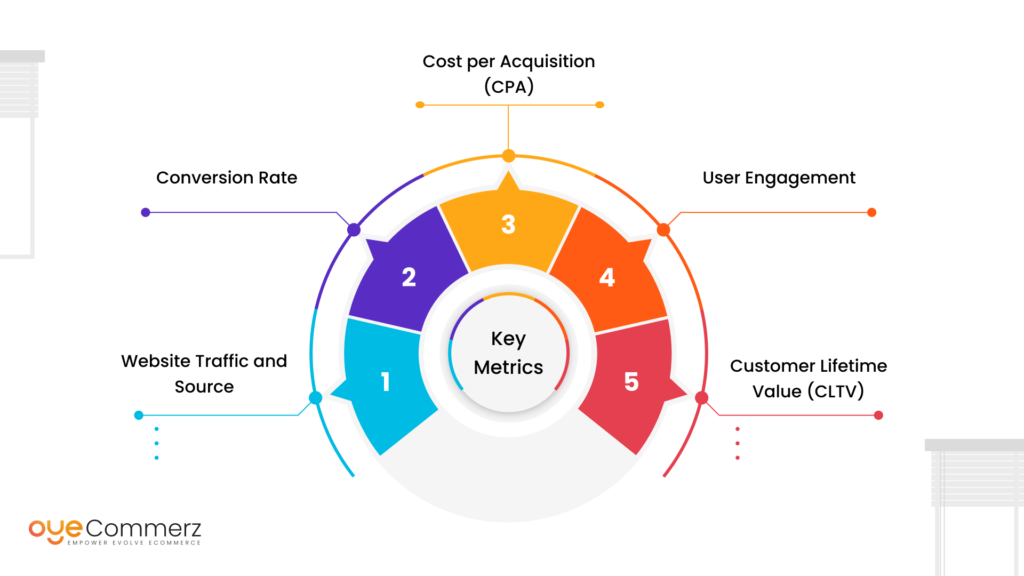
Measuring and evaluating marketing efforts involves monitoring marketing strategies and processes to determine the effectiveness of the existing marketing strategies and implement changes that can enhance marketing campaigns. It is an essential process that enables you to learn what approach is effective, which one is not, and where you require alterations for the sake of a better performance of your marketing agenda.
Key Metrics to Track
Website Traffic and Source
- Total Visitors: Calculate the total number of visitors to the website, which gives general impressions about the website.
- Traffic Sources: Determine the source of traffic which may comprise organic search, social media, direct traffic, or through links. It assists you in knowing which channel is generating more traffic and then focusing more on that specific area.
- User Behavior: Use such parameters as average session time and bounce rate to determine the quality of traffic and users on the website.
Conversion Rate
- Definition: The conversion rate tells you how many people out of the ones who visit your site are willing to download your app or subscribe to the newsletter, for example.
- Tracking Tools: Google Analytics can, for instance, be used for defining and tracking such targets as conversion goals. This is useful in determining the effectiveness of your website or landing page in converting visitors into users.
- Optimization: A low conversion rate might be a problem with the landing page, the message, or the user experience. Finding out which single elements to optimize for increasing the number of conversions (split testing – A/B testing).
Cost per Acquisition (CPA)
- Definition: CPA tends to quantify the cost involved in gaining a new customer. The formula is pretty straightforward, it’s your total marketing expenses divided by the number of new customers you’ve managed to attract.
- Importance: The mentioned CPA is quite important as it can be used to evaluate the effectiveness of the provided marketing. A high CPA means that it is actually costing you a lot and the results are not worth it therefore campaigns require some tweaking.
- Optimization: Always ensure you change your advertising budgets, targeting, your ad creatives to look forward to a reduced CPA and better ROI.
User Engagement
- In-App Behavior: Map out the behavior of users with your application, for example how often users engage features, frequency of sessions, and actions within the application. This helps you to have a sense of what the user wants and what you ought to do for him or her.
- Retention Rates: Keep a record of How many of the users remain engaged with your app in the long run. A high percentage of users can be considered to stay and come back to your app as they ‘receiving more value for their money, low percentage of users can be attributed to many factors such as dissatisfaction with your app or the application’s failure to meet users’ expectations.
- Feedback and Reviews: This way look at the user feedback and their reviews to know how satisfied the users are and where the company needs to improve.
Customer Lifetime Value (CLTV)
- Definition: CLTV is an index of total revenue a given customer would generate throughout the entire period of his association with the firm. It is determined as the average purchase value, the number of times that a customer is likely to purchase a product, and the average length of life span of the customer.
- Importance: Knowledge of CLTV gives you a point of reference in evaluating your customer’s profitability and the strategies you use to attract valuable customers.
- Optimization: Improve CLTV by making transactions result in a better user experience, offering more targeted products that could be of interest to the customer, and offering better customer support to create a long-lasting relationship.
How to Choose the Best E-Commerce Marketing Strategy for Your Shopify Store
Selecting the right e-commerce marketing strategy for your Shopify store is critical to driving traffic, increasing conversions, and ensuring long-term success. With various marketing choices available, it’s important to use your strategy based on your business goals, target audience, and available resources. Here’s how to select the most working marketing approach for your Shopify store
1. Understand Your Audience
The first phase in selecting a marketing strategy is to empathize with your target audience. Conduct in-depth research to determine who your potential customers are, their shopping behaviours, preferences, and pain points. Use tools like Google Analytics, Shopify’s customer insights, and social media analytics to gather demographic and behavioural data. Once you have a clear understanding of your audience, choose marketing tactics that align with their preferences, such as social media marketing for younger demographics or email marketing for repeat customers.
2. Define Your Business Goals
Your marketing techniques should match with your business goals. Are you concentrated on brand recognition, customer retention, or driving regular purchases? If your goal is to optimise traffic and visibility, search engine optimization (SEO) or content marketing may be your best solution. For fast sales, consider pay-per-click (PPC) advertising or influencer marketing. Preparing your business goals helps in selecting strategies that will be most helpful for marketing.
3. Leverage Your Strengths
Identify your store’s unique strengths and use them to your advantage. If you have a visually attractive product, Mediums like Instagram or Pinterest may help show your products. For those with high-value customer feedback or case studies, content marketing through blogs or customer success stories can highlight your credibility and authority.
4. Budget Considerations
Marketing budgets frequently play a major role in deciding which strategy to use. Natural strategies like SEO and content marketing need time but bring long-term benefits. Paid strategies, like PPC or social media advertising, can provide easy results but require an investment. Consider your budget and choose approaches that offer the best return on investment (ROI) for your store.
5. Test and Iterate
Don’t assume the first strategy you choose will give you the best results right away. Add A/B testing to different marketing channels to check which one gives you more engagement, conversions, and traffic than the current one. Regularly assess the performance of your marketing campaigns using tools like Google Analytics, Shopify’s dashboard, or third-party analytics tools to track KPIs (Key Performance Indicators).
6. Combine Multiple Strategies
The most successful approach is multiple strategies. For instance, you might pair SEO with email marketing to capture organic traffic and nurture leads. Merging content marketing with social media can increase your reach. By implementing various methods, you can develop a well-prepared approach that picks customers at different stages of sales.
Join The League of Successful Businesses with OyeCommerz!
At OyeCommerz, we specialize in crafting tailored digital marketing strategies that drive app visibility, engagement, and downloads. Oyecommerz’s shopify app expert team combines cutting-edge techniques with industry insights to ensure your app stands out in a crowded market. From optimizing your app store presence to leveraging targeted advertising and content marketing, we’ve got you covered.
Don’t leave your app’s success to chance—partner with OyeCommerz and watch your app thrive. Contact us today to get started and transform your digital marketing approach!
Contact to Build your Shopify App Now
Conclusion
This was the Best Digital marketing strategies for Promoting Shopify apps. Digital Marketing is a continuous process that involves a mix of creativity, technical knowledge, and data-driven optimization. By implementing these strategies, from content marketing to app store optimization and technical onboarding, you can ensure that your Shopify app gains visibility, attracts users, and achieves long-term success.
Frequently asked questions about Shopify app marketing
How can I effectively promote my Shopify app?
To effectively promote your Shopify app, consider implementing a combination of strategies such as optimizing your app’s product page, leveraging social media channels, engaging in email marketing, utilizing SEO and App Store Optimization (ASO), and creating valuable content to attract and retain users.
What role does content marketing play in promoting a Shopify app?
Content marketing plays a vital role by providing valuable information that resonates with your target audience. By creating blog posts, tutorials, and guides, you can establish authority, build trust, and attract users who may be interested in your app.
What are some common mistakes to avoid in marketing a Shopify app?
Common mistakes to avoid include neglecting SEO and ASO, failing to engage with your audience on social media, not tracking performance metrics, and overlooking the importance of user feedback. Ensure you have a well-rounded marketing strategy that addresses these areas for maximum effectiveness.
How often should I update my marketing strategy?
Your marketing strategy should be reviewed and updated regularly—at least quarterly. Analyze performance metrics, gather user feedback, and stay informed about market trends to adjust your tactics and ensure continued relevance and effectiveness.

